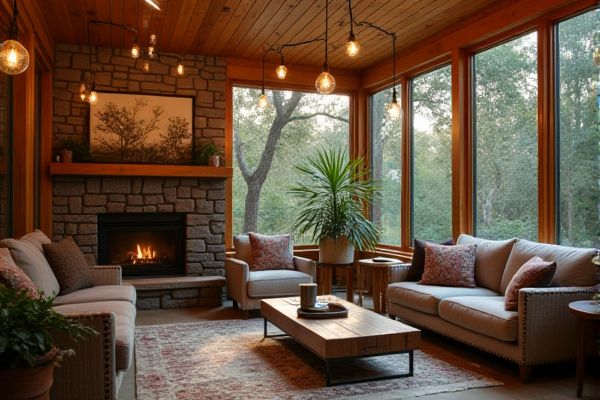
Edison bulbs provide a warm, nostalgic glow perfect for creating cozy ambiance in your sunroom, while LED bulbs offer energy-efficient brightness with customizable color temperatures to suit various moods. Explore the rest of the article to determine which lighting option enhances your sunroom's atmosphere and functionality the best.
Table of Comparison
| Feature | Edison Bulbs | LED Bulbs (Sunroom) |
|---|---|---|
| Energy Consumption | 40-60 Watts | 8-12 Watts (Energy Efficient) |
| Lifespan | 1,000 - 2,000 hours | 25,000 - 50,000 hours |
| Light Quality | Warm Amber Glow, Vintage Style | Adjustable Color Temperature (2700K-6500K), Natural Daylight |
| Heat Emission | High Heat Output | Low Heat Output |
| Cost | Lower Initial Cost | Higher Initial Cost, Lower Long-Term Cost |
| Compatibility | Traditional Fixtures | Wide Fixture Compatibility, Smart Home Integration |
| Environmental Impact | Higher Energy Use, More Waste | Eco-Friendly, Reduced Carbon Footprint |
| Recommended Use in Sunroom | For Ambiance and Vintage Aesthetics | For Bright, Energy-Efficient, Versatile Lighting |
Introduction to Sunroom Lighting
Sunroom lighting requires a balance between aesthetic appeal and energy efficiency, where Edison bulbs offer a warm, vintage glow that enhances the cozy ambiance. LED bulbs provide superior energy savings, longer lifespan, and adjustable color temperatures that can mimic natural sunlight, making them ideal for brightening your sunroom throughout the day. Choosing between Edison and LED bulbs depends on your preference for style versus performance and how you want to illuminate your sunroom space.
What Are Edison Bulbs?
Edison bulbs are vintage-style incandescent light bulbs characterized by their exposed filaments and warm amber glow, making them popular for creating a nostalgic and cozy atmosphere in sunrooms. These bulbs typically consume more energy and have shorter lifespans compared to modern LED bulbs, which offer greater energy efficiency and cooler, adjustable lighting options. Choosing Edison bulbs for your sunroom prioritizes aesthetic appeal, while LED bulbs provide enhanced durability and energy savings.
What Are LED Bulbs?
LED bulbs are energy-efficient lighting devices that use light-emitting diodes to produce illumination, consuming significantly less power than traditional Edison bulbs. In a sunroom, LED bulbs offer long-lasting brightness with minimal heat emission, making your space comfortable and eco-friendly. Their durability and reduced energy use help lower maintenance costs while enhancing natural light without compromising aesthetic appeal.
Aesthetic Appeal: Edison Bulbs vs LED Bulbs
Edison bulbs offer a warm, vintage glow with exposed filaments, creating a nostalgic and cozy ambiance ideal for sunroom aesthetics. LED bulbs provide versatile lighting options with adjustable color temperatures, enhancing brightness while maintaining energy efficiency in sunroom settings. Choosing between Edison and LED bulbs depends on whether the primary goal is classic visual charm or modern, customizable illumination.
Energy Efficiency Comparison
Edison bulbs consume significantly more energy, typically around 40-60 watts, compared to LED bulbs that use only 6-10 watts for equivalent brightness, making LEDs far more energy-efficient for sunroom lighting. LED bulbs convert more electricity into light rather than heat, reducing energy waste and lowering electricity bills in sunrooms where lighting may be used for extended periods. Over the lifespan of approximately 25,000 hours for LED bulbs versus 1,000 hours for Edison bulbs, LEDs offer substantial long-term energy savings and environmental benefits.
Lifespan and Maintenance Needs
Edison bulbs typically have a lifespan of around 1,000 to 2,000 hours and require frequent replacements, making them less ideal for a sunroom where consistent lighting is desired. LED bulbs offer a significantly longer lifespan, often exceeding 25,000 hours, and demand minimal maintenance, reducing both cost and hassle over time. Choosing LED bulbs for your sunroom ensures durable, energy-efficient lighting that maintains brightness without frequent upkeep.
Brightness and Light Quality in Sunrooms
Edison bulbs emit a warm, amber glow that creates a cozy atmosphere but typically offer lower brightness levels, making them ideal for accent lighting in sunrooms. LED bulbs provide higher brightness with customizable color temperatures, allowing you to mimic natural daylight or choose warmer tones to enhance the sunroom's vibrancy and usability. Selecting LED bulbs ensures energy efficiency and consistent light quality, which boosts visibility and enhances the overall ambiance of your sunroom.
Cost Analysis: Upfront and Long-term
Edison bulbs have a lower upfront cost but consume more energy, leading to higher electricity bills in your sunroom over time. LED bulbs, though pricier initially, offer significant savings by using up to 80% less energy and lasting up to 25 times longer than Edison bulbs. Investing in LED lighting optimizes long-term cost efficiency and reduces maintenance expenses in your sunroom.
Environmental Impact
Edison bulbs consume significantly more energy and have shorter lifespans compared to LED bulbs, leading to increased carbon emissions and resource waste in sunroom lighting. LED bulbs use up to 80% less electricity and last up to 25 times longer, reducing both energy consumption and landfill waste. Choosing LED bulbs for sunrooms supports sustainable energy use and minimizes environmental impact through lower greenhouse gas emissions and fewer replacement cycles.
Choosing the Best Bulb for Your Sunroom
Edison bulbs offer a warm, vintage glow ideal for creating a cozy, nostalgic ambiance in your sunroom, but they consume more energy and have shorter lifespans compared to LED bulbs. LED bulbs provide superior energy efficiency, longer durability--often exceeding 25,000 hours--and customizable color temperatures that can mimic natural daylight, enhancing the bright and airy feel of a sunroom. For optimal lighting, LED bulbs are the preferred choice, balancing aesthetic appeal with cost-effective, eco-friendly performance in sunroom settings.
 homyna.com
homyna.com